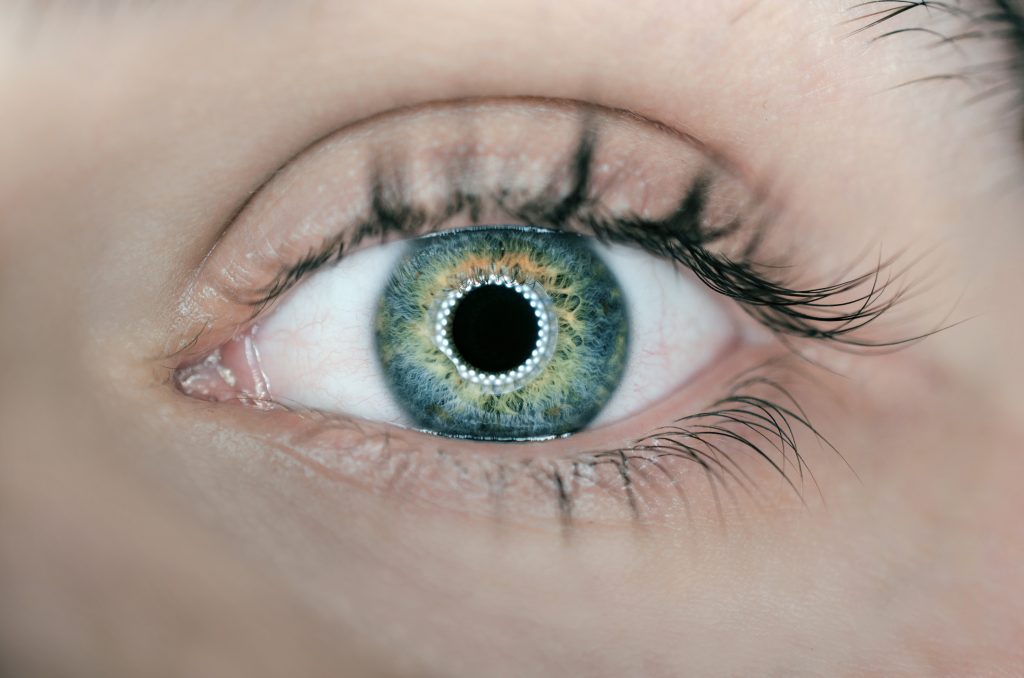This post is also available in Dutch.
Measuring pupil size has become an increasingly popular method in psychology and neuroscience research. Read on to find out what pupil size can tell us about the mind and brain.
There is something very personal about looking into someone’s eyes. We have long been fascinated by what our eyes can say about us. One popular belief is that large pupils are a sign of love or attraction. Another is that the pupils get larger when we tell a lie. There is, in fact, some truth to these ideas: The size of our pupils can provide meaningful clues about what we are thinking and feeling. This blog will discuss how scientists use pupil size to gain insight into our mental experience.
What is Pupillometry?
Pupillometry refers to the scientific measurement of pupil size. The size of our pupil is largely dependent on the current light conditions: Pupils dilate (i.e., get wider) to let in more light when the environment is dark, whereas they constrict in brighter environments. Interestingly, pupil size can also change in response to different mental processes, such as memory or attention, even when the light conditions do not change. Pupillometry has therefore become an increasingly popular way for scientists to gain insight into mental processes: between 2001 and 2019, the number of scientific papers talking about pupillometry increased from only 5 to nearly 200. But what does pupil size actually tell us about the mind and brain?
When discussing the pupil, we can distinguish between the baseline pupil size and the pupil response to a task.

This graph shows an example of how the pupil size for two different people (black and blue lines) might look while they perform the task of pushing a button whenever they see a green circle. The grey line shows the difference in baseline pupil size between the two people, and the red lines show each person’s pupil response to the green circle.
Baseline pupil size
Baseline pupil size can reflect our levels of arousal or alertness: Our pupils are small when we feel tired, whereas they become large when we feel excited or restless. If the goal is to be focused on a task, the sweet spot appears to lie somewhere in the middle, with an intermediate baseline pupil size. When the baseline pupil size is small or large, people are more likely to have lapses in attention. Indeed, researchers using pupillometry often notice that during boring, repetitive tasks, participants’ pupils become smaller as they get sleepy.
Pupil response
The pupil also temporarily fluctuates in size in response to the task a person is performing: It begins to increase when the mental process begins, then reaches a peak, and decreases back to the baseline. We think that this pupil response reflects the mental effort of people participating in a task: When they are trying harder at a task, their pupils dilate more. For example, pupil dilation becomes greater when tasks become more difficult (like remembering more items or needing to ignore a distracting stimulus), or when good performance can be rewarded.
The pupil and the brain
But why does our pupil size reflect our engagement and effort in a task? Both baseline and change in pupil size have been linked with the activity of the locus-coeruleus, a part of the brain responsible for delivering the chemical noradrenaline (also known as norepinephrine) throughout the brain. Scientists have long known that noradrenaline levels in the brain are related to how alert we are. Noradrenaline may also help us decide when to focus on our current task and when to opt for exploring other options in our environment, which can help explain why baseline pupil size predicts whether our mind will wander. Noradrenaline release has also been linked to the exertion of effort.
In sum, researchers can use pupillometry to check people’s alertness, engagement, and effort in a task at any moment, and deduce the actions of the locus coeruleus without relying on more invasive procedures. But can we really “see the mind” through the eyes, to know whether someone is in love, or when they are lying? If a person is feeling attraction, they will probably be more alert, and if a person is lying they may be mentally working harder than if they were telling the truth, both of which will result in larger pupils. However, changes in pupil size are not specific to particular types of thoughts and feelings – for example, maybe instead of lying, a person is just thinking hard to remember what they ate for lunch and their pupils dilate. These non-specific pieces of information are still very useful to scientists when measured in an experiment, because the controlled setting makes it easier to deduce why the pupil size is changing. Thus, pupillometry will continue to be an important tool for studying the mind and brain.
Further reading:
Researchers measure pupil size using an eye tracker – See this post for more information on eye tracking.
Author: Rebecca Calcott
Buddy: Joao Guimaraes
Editor: Mónica Wagner
Translator: Jill Naaijen
Editor Translation: Wessel Hieselaar
